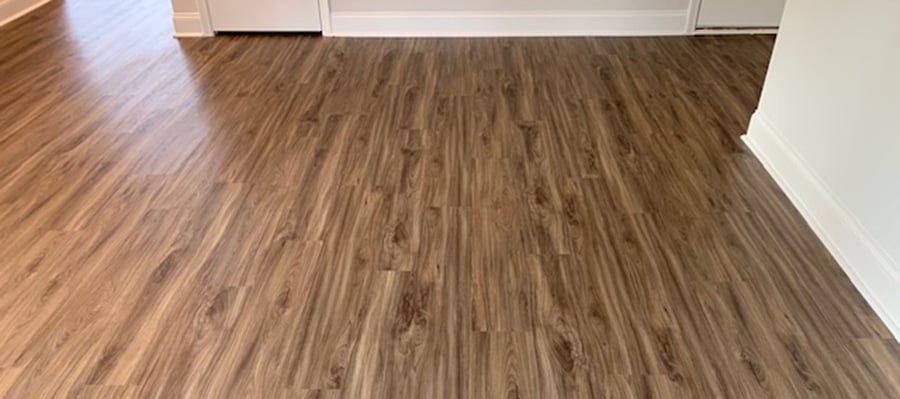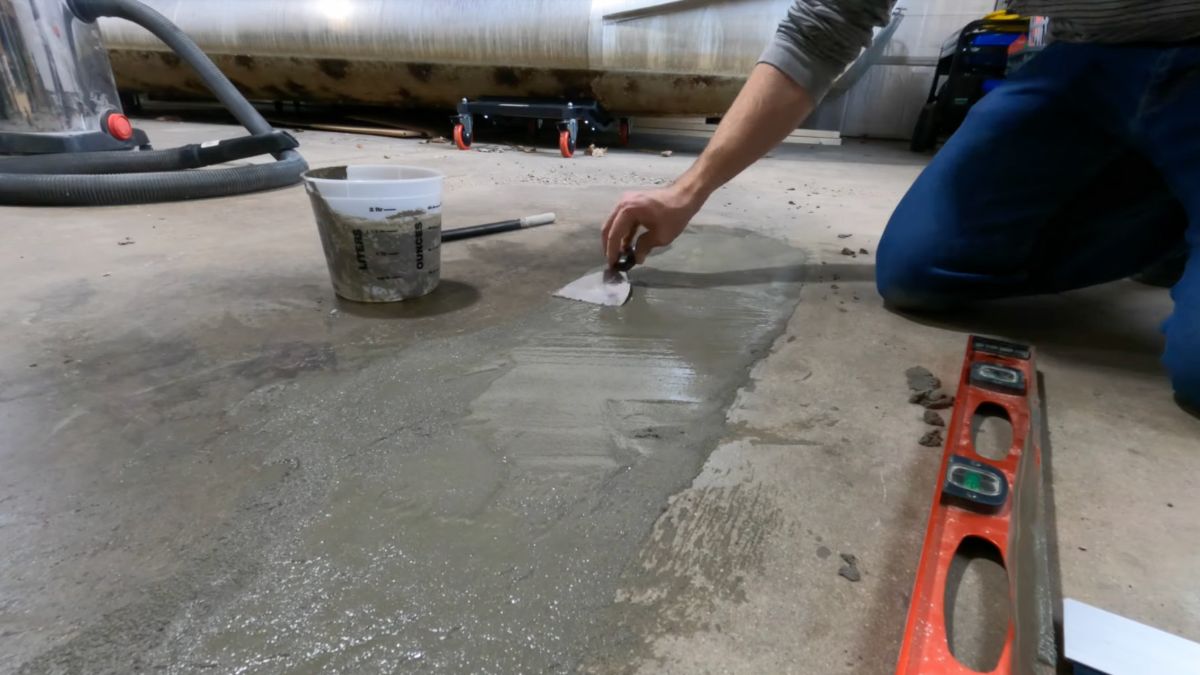
If you have chosen to install the floating floor in your house, you may have asked yourself if you can glue a floating floor. Well, you have come to the right place as I will share my experience about the same in this article.
Floating laminate floors are not intended to be glued down. Floating laminate floors can move with temperature, and gluing down the planks can damage them. If installing in a wet area, like a bathroom, you should glue the laminate planks to seal the tongue and groove seams from moisture.
There are some instances where you may want to glue down a floating floor. You should read your manufacturer’s instruction manual before gluing your floating floor down as you might void your warranty.
There may be multiple reasons you want to use glue for a floating floor, whether it might strengthen the bonds of the click lock system floating floors or to eliminate squeaking and crackling noises, which is a common problem in floating floors. We will cover all these things in this article.
Should You Glue Down Floating Floors
Gluing floating laminate flooring is unnecessary, but some manufacturers account for the need to glue down their floating floor products.
If there is nothing wrong with your installation, there is no tangible reason for you to attempt to glue down your floating floor. Also, at the installation time, gluing down your floating floor should not be your primary option.
Gluing your floating floor should not be considered unless the floor is perfectly level. Also, with a sound proof padding under your floating floor, you would not be able to glue the flooring down. Therefore, by gluing the flooring down, you’ll lose the benefits the padding provides, like noise reduction and thermal resistance.
Having said that, there are some reasons for gluing your floating floor down that should be taken into consideration.
Suppose your installation of the floating floor makes an annoying squeaky or creaking sound. After considering all factors, you conclude that the cause of the noise is due to improper installation. In that case, one of your options will be to glue the floating floor down.
Another reason for gluing down your floating floor is the movement of the planks. Since the floating floor floats over the floor, there is a tendency for it to move over time slightly. If this movement annoys or disturbs you, you can consider gluing down your floating floor.
Gluing down your floating board makes it reasonably permanent. Its removal without damage might end up being impossible. Additional costs will also arise through the purchase of the glue required.
Also, gluing down your floating floor might shorten its lifespan since it loses some resilience when it is secured to the subfloor.
The manufacturer’s warranty covers material defects; gluing down your floating floors might translate into voiding the warranty. The company may argue that whatever damages or defects exist is because the flooring was not installed correctly.
What Type of Floating Planks Can Be Glued Down

Can You Glue Floating Vinyl Floor?
Vinyl plank flooring can either be floated or glued down, depending on the flooring type. Glued applications typically require a specific adhesive or have a built-in peel-away adhesive. Floating vinyl planks have a click-lock system that has no adhesive requirements.
While floating your vinyl floor might be suitable for small rooms like bathrooms and kitchens, it might be more advisable to use a glue-down product in larger rooms to ensure durability.
Gluing down your vinyl floor can ensure that high-traffic areas hold up over time. It dramatically reduces the chance of the floor lifting or moving around, especially if heavy items rest on the floor or things are moved or rolled around frequently.
You should know that repair in glued down floating vinyl floors is easier because the planks do not lock together, meaning you can remove and replace only the damaged plank.
Can You Glue Down Click Lock Vinyl Floor
The floating click lock vinyl floor has a locking system that is relatively easy to install. The click lock vinyl floor is ideal for small rooms. When used in larger spaces, there could be less joint stability depending on the flooring quality.
Barring any problem or difficulty, there may not be a need to glue down your click lock vinyl floor. This is not to say you cannot glue it down.
The click and lock vinyl floor system can either be floated or glued down. Primarily, this system requires absolutely no glue because all that is needed is to essentially lock both edges of the flooring together.
Some reasons why gluing down your click lock vinyl plank flooring include; trying to eliminate the squeaky or creaky sound it produces (which might be due to an uneven sublayer) or prevent the movement of the floor. No amount of adhesive will prevent a squeaking that comes from a subfloor. You’ll need to have a contractor correct this before installation.
Can You Glue Down Engineered Hardwood
When it comes to engineered hardwood, it is no stranger to glue. It can be either floated or glued down. The most popular method of installing engineered hardwood is gluing it down.
Engineered hardwood flooring is more stable when glued down. When it comes to concrete or wood subfloors, gluing down your engineered hardwood flooring might be the most appropriate option. However, the substrate needs prepping to level the surface and prevent popping.
If your engineered hardwood floor is glued down, there is a little chance of it shifting below your feet when you walk across it, thereby eliminating all kinds of noise and giving the floor a firmer feeling underfoot.

The Correct Way to Glue Floating Floors
Since it has been established that although it is not recommended to glue down your floating floor, it is a possible feat if you have decided to do so.
While methods/techniques of gluing down floating floorboards may differ, the most common method is the edge gluing technique. The edge gluing process involves the gluing of the plank edges to hold them in place. This is done in wet areas like bathrooms which allows the glue to resist water intrusion under the planks through the seams.
Before moving forwards, let’s take a look at all tools you need to have in your arsenal before gluing down the floating floor.
The Edge Glue Technique
STEP 1; ENSURE THAT THE FLOORS TO BE GLUED DOWN ARE IN GOOD CONDITIONS
Gluing floorboards together is a relatively easy handiwork skill. Ensuring that the floating boards to be glued down are in healthy conditions will go a long way in saving you from undue stress. Try to look out for boards with similar colors or patterns. Also, check to see if the planks are straight, flat, and not twisted.
STEP 2; ARRANGE THE BOARD IN THE POSITION YOU DEEM BEST.
Try to make sure that the best-looking side of each floorboard is the one that is facing upward. Arrange the pieces to fit in a way that ensures the best appearance.
STEP 3; SPREAD THE BEAD OF GLUE IN AN EVEN MANNER
To ensure that the glue is evenly spread, move the glue bottle quickly along the board. It would help if you used a spring clamp to hold the board in an upright position while you glue.
Also, there is only a need for you to apply glue to just one of the surfaces being glued together.
STEP 4; PRESS THE TWO BOARDS BEING GLUED TOGETHER
The best way to spread glue on the boards’ edges is to press the two edges being glued together and slide against to and fro against each other.
STEP 5; BEFORE CLAMPING, TRY TO INSPECT THE GLUE JOINTS
You should separate the boards and inspect the edges. Inspect to ensure a thin and even layer of glue on each side of the board.
After doing this, apply a little more glue and clamp together.
STEP 6; CLAMPING
After clamping the two pieces of boards to be joined together, there should be an even beard of glue squeezed out across the entire surface of the board.
STEP 7; ALIGN THE TOP SURFACE WITH A LOT OF CARE
A lot of effort that might go into sanding the board’s surface might be saved if the aligned boards’ surfaces are correctly aligned.
STEP 8; SCRAPE OFF THE EXCESS GLUE
Once the squeezed out excess glue changes its state from liquid to jelly-like state, scrape it off. This change in the state should happen in about 20 minutes under normal conditions.
STEP 9; FLATTEN ALL IRREGULAR SURFACES
Before you can say your operation is successful, try to check all the surfaces for irregularities. Straighten all crooked fittings and try to flatten all swelled-up surfaces before the glue dries up totally.
Now you have become aware of whether you can glue your floating floor or not and the best way to do that if allowed. I hope this article helped you in clearing your doubts about gluing floating floors.






